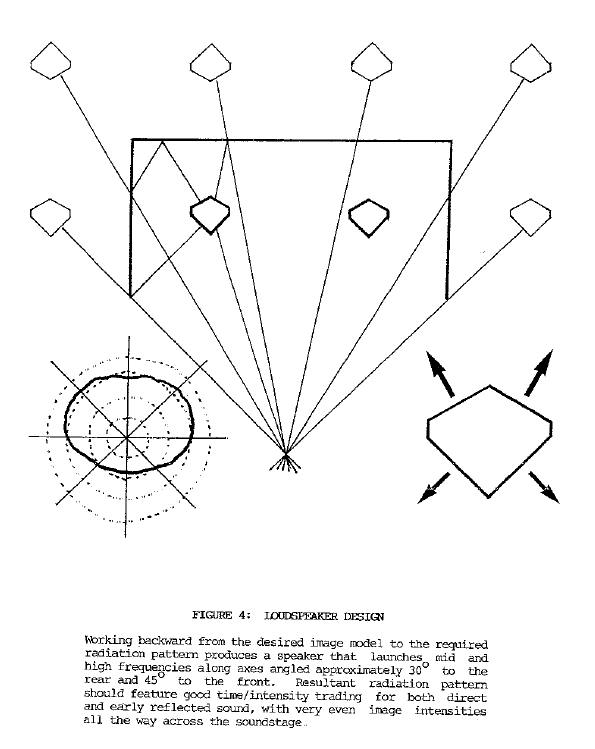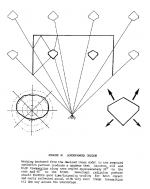I noticed when reading reports from RMAF that many people raved about the NOLA speaker, which has four widely spaced tweeters and four small widely spaced midrange drivers in an open baffle. Maybe this has similar traits to the IMP, or Bose 901, etc. Turns out to be a crowd pleaser.
The listening test was termed as "The Linkwitz Challenge"
The purpose being to challenge the old and receive the new information ? I hope. Who wants to hang out with the second (or the third) if there is the winner ?
I am continually amazed how hundreds of posts can be generated about a paper nobody read. A real feat!
Siegfried Linkwitz, “The Challenge to Find the Optimum Radiation Pattern and Placement of Stereo Loudspeakers in a Room for the Creation of Phantom Sources and Simultaneous Masking of Real Sources,”
jan
An unarguable fact is generally people like sound which is more spacious than dry. IMP seems to generate highly favourable field with low correlation between direct and reflected sound. Naturalness of the sound field can be high in this case. This can lead to high listener preference.
I think the trial should also have included a home theatre receiver with Dolby Pro Logic and a couple of hidden rear speakers. This provides an instant 'spacious effect' even from ordinary stereo, and I strongly suspect that quite a few people would like it - as long as they didn't know how it was done.
I think the trial should also have included a home theatre receiver with Dolby Pro Logic and a couple of hidden rear speakers. This provides an instant 'spacious effect' even from ordinary stereo, and I strongly suspect that quite a few people would like it - as long as they didn't know how it was done.
I use DPL2 for all of my listening at home. It does increase spaciousness, and improve image focus and definition, too due to the hard center.
I don't recommend such use if one's center channel is not absolutely identical to the right and left speakers, though. There are two ways to do a center channel: identical speaker at the same height and in the same orientation, and flawed.
Forget it Elias, most people don't want to consider something new. Most people just want validation of there own beliefs. That's why we are talking about 2nd place! Why challenge ourselves with the notion that we may have been wrong all along by discussing the loudspeaker that actually came out 1st?
That's no fun
you will be pleased to hear I finally built the barrier and tried it with the Orions.
I use DPL2 for all of my listening at home. It does increase spaciousness, and improve image focus and definition, too due to the hard center.
I don't recommend such use if one's center channel is not absolutely identical to the right and left speakers, though. There are two ways to do a center channel: identical speaker at the same height and in the same orientation, and flawed.
During some of my early experiments with active speakers and phase/amplitude correction, I messed up the DSP code so that the phase correction was all wrong. Through the crossover regions, the drivers were effectively blending with individual added intricate phase shifts. Depending on the settings, it sounded amazing! If I was seeking some sort of spaciousness illusion, and was presented with this stereo image from two speaker boxes, I might be tempted to think I had finally hit audio Nirvana.
Having heard several NOLA models more than once, I would agree that they are large and open sounding. I like that sound. They are a little too aggressive in the midrange for my tastes, but a lot of people don't mind that. (Many speakers are like that).I noticed when reading reports from RMAF that many people raved about the NOLA speaker....
ah! finally it's getting interesting..
what is the difference between Gary's speaker and a real omni source? Same purpose isn't it?
According to his 'image model theory' the ideal speaker directivity looks like this:
https://docs.google.com/file/d/0B0T6TlNEclozZTcxZGUxNTctNmNhMC00MDFjLTk0MzUtY2NkZjU2M2ViMDYw/edit?hl=en&pli=1
It should have 4 main lobes, and the rear lobes should be stronger than the front lobes. This way the speaker interacts ideally with the listening room according to the theory.
Attachments
Funny, isn't it. I had the good fortune to attend a preliminary presentation of that material:I am continually amazed how hundreds of posts can be generated about a paper nobody read. A real feat!
Siegfried Linkwitz, “The Challenge to Find the Optimum Radiation Pattern and Placement of Stereo Loudspeakers in a Room for the Creation of Phantom Sources and Simultaneous Masking of Real Sources,”
AES Section Meeting Reports
San Francisco - May 6, 2008
Siegfried Linkwitz, AES San Francisco May 6th 2008
Meeting Topic:Accurate sound reproduction from two loudspeakers in a living room
Moderator Name:Conrad Cooke
Speaker Name:Siegfried Linkwitz - Linkwitz labs
Meeting Location:Ex'pression College for Digital Arts, Emeryville.CA USA
Lots of "now familiar" material, reflection diagrams and all that, and as is usual with SL lots of discussion and acknowledgement of "prior art" as well. I asked, and we spoke briefly, about the ORION radiation pattern issue at that meeting. I have to laugh when I hear (now) that he wasn't aware of it . . .
you will be pleased to hear I finally built the barrier and tried it with the Orions.
OK! talk to me bud. what do ya think?
how close together were the Orions?
Maybe you could post your experience on the ambiophonic thread, I believe it needs a fresh voice over there
Last edited:
It should have 4 main lobes, and the rear lobes should be stronger than the front lobes. This way the speaker interacts ideally with the listening room according to the theory.
I see that the rear radiation is 6db louder than direct. This will be equal in amplitude considering the distance from the listener, but very delayed.....where as the sidewall reflection is 6db less than direct.
Your invention uses stronger sidewall reflections compared to direct, yes?
So this is something to talk about.
ah! finally it's getting interesting..
what is the difference between Gary's speaker and a real omni source? Same purpose isn't it?
I suppose his speaker relies more on controlled reflections, the rear speakers are actually 6db louder than direct and the side firing drivers are 6db less. I suppose its more of a flooder/omni. A true omni will always have a stronger direct sound and the amplitude of reflections are controlled by how near the speakers are to the boundries, also how close the listener is (out of the reverbient feild)
While I have no issues with too strong masking with my omnis as I choose a pretty close up listening seat at less than 2m, I do have an old note about something to try one day...That's the whole magic of wide dispersion speakers: reflections from other locations than the direct sound.
The problem is that there's now probably too much energy in the room which masks low level details in the recording.
And that is: Take a Suma type of speaker and add a small FR speaker at the side of the box pointing outwards. Maybe 1KHz up for the ASW region of F. Or use a tweeter in a WG producing a more narrow "ray" for the same matter. Powered by a stereo amp to control the level independently and add delay as necessary. Should be easier than a cardio.So the trick is to add single strong first reflections while keeping the level of the diffuse sound field low. All the talking about Orion vs. Behringer is really just a sideshow.
According to his 'image model theory' the ideal speaker directivity looks like this:

https://docs.google.com/file/d/0B0T6TlNEclozZTcxZGUxNTctNmNhMC00MDFjLTk0MzUtY2NkZjU2M2ViMDYw/edit?hl=en&pli=1
It should have 4 main lobes, and the rear lobes should be stronger than the front lobes. This way the speaker interacts ideally with the listening room according to the theory.
I think the drawing is to be taken as a rough sketch - not saying that there should exactly 4 lobes as shown. What this drawing tells me is that I should have an omni or dipole pattern with a certain all-around shape, not something with 4 beam (which would be pretty impossible to build anyway).
jan
I have listened to stereo and PLIIMusic side by side for 12 years in 3 different rooms. I prefer PLII mostly, propably because my listening rooms are not symmetrical enough for stereo and reflections.
PLII has adjustment to level, delay and "center width" which is propably phase shift. It is possible to change the sound with these parameters to your own liking. I prefer a quite minimal "spaciousness". Most seats in our living room are not even close to the "optimal center" and this setup works very well.
Stereo in good symmetrical environment for a hot spot is amazing too, but just for that one spot. I can sit there too and move the main speakers, if I'm alone at home which happens seldom.
PLII has adjustment to level, delay and "center width" which is propably phase shift. It is possible to change the sound with these parameters to your own liking. I prefer a quite minimal "spaciousness". Most seats in our living room are not even close to the "optimal center" and this setup works very well.
Stereo in good symmetrical environment for a hot spot is amazing too, but just for that one spot. I can sit there too and move the main speakers, if I'm alone at home which happens seldom.
I think the drawing is to be taken as a rough sketch - not saying that there should exactly 4 lobes as shown. What this drawing tells me is that I should have an omni or dipole pattern with a certain all-around shape, not something with 4 beam (which would be pretty impossible to build anyway).
jan
it does look very dipole like, but he can control the reflection level! not a bad idea?
Is the polar for the Orions right on the powerpoint? Seems a bit strange, no?
Last edited:
OK! talk to me bud. what do ya think?
how close together were the Orions?
Maybe you could post your experience on the ambiophonic thread, I believe it needs a fresh voice over there
it worked! but... drum rolls.. in that application the Orions got beaten by a 50$ small 2way, go wonder.
Then back to stereo triangle.. Ah, still great these Orions!
I will put a post in the ambio thread, but can't find my camera!!
And that is: Take a Suma type of speaker and add a small FR speaker at the side of the box pointing outwards. Maybe 1KHz up for the ASW region of F. Or use a tweeter in a WG producing a more narrow "ray" for the same matter. Powered by a stereo amp to control the level independently and add delay as necessary. Should be easier than a cardio.
...or simply use 4 speakers and delay the outer pair.
In my experience some second order reflections from higher up contribute to spaciousness as well. A cardioid could deliver that. I'm not sure if it's feasible to implement such a behavior in a high directivity design.
On the other hand, a cardio radiates most of its energy into undesirable directions reducing the D/R ratio. But it's still better than a dipole.
- Home
- Loudspeakers
- Multi-Way
- Linkwitz Orions beaten by Behringer.... what!!?
